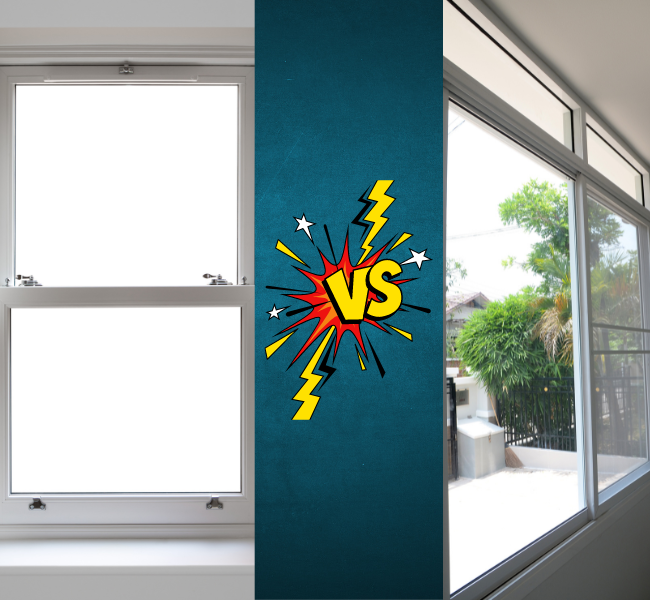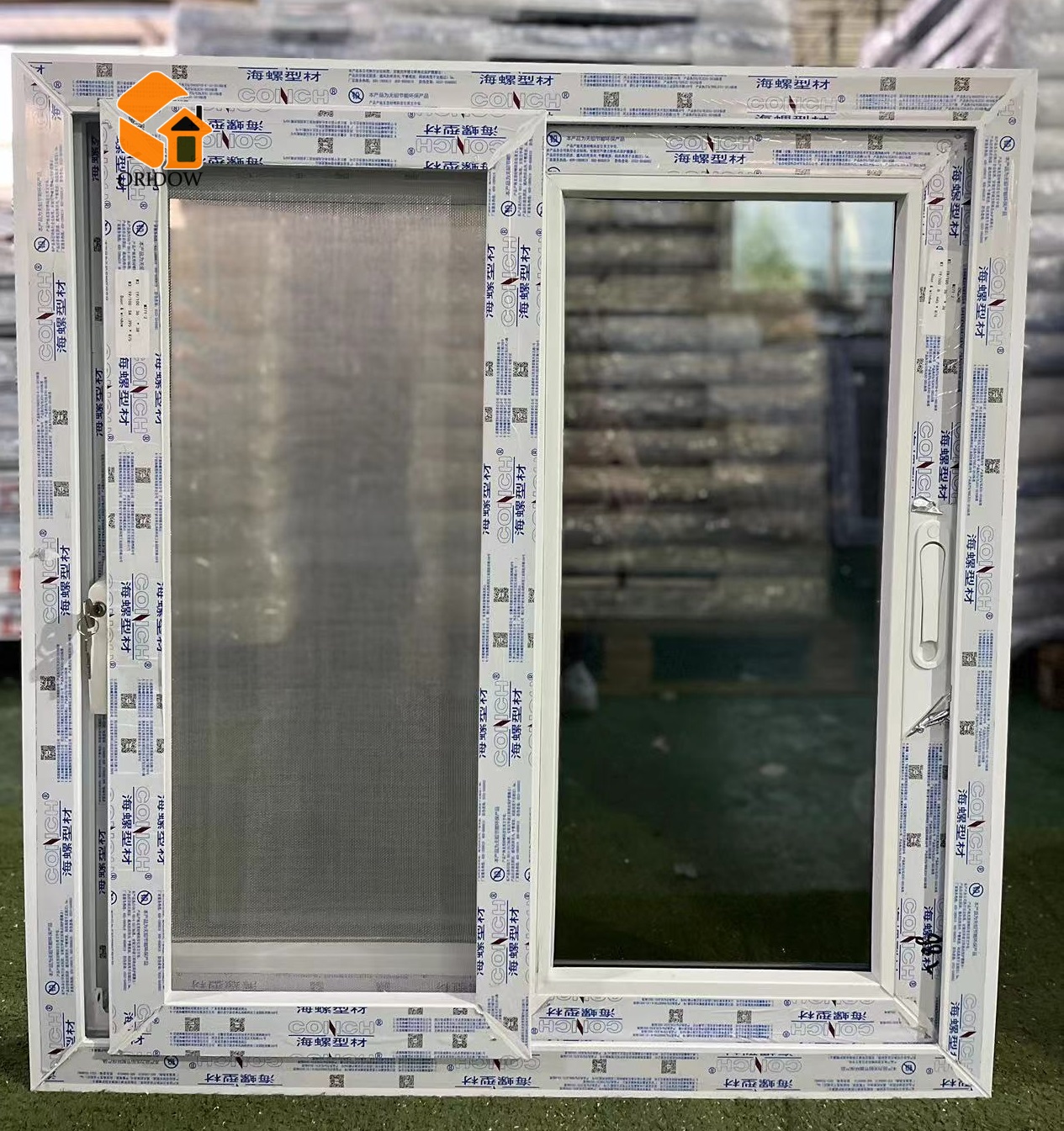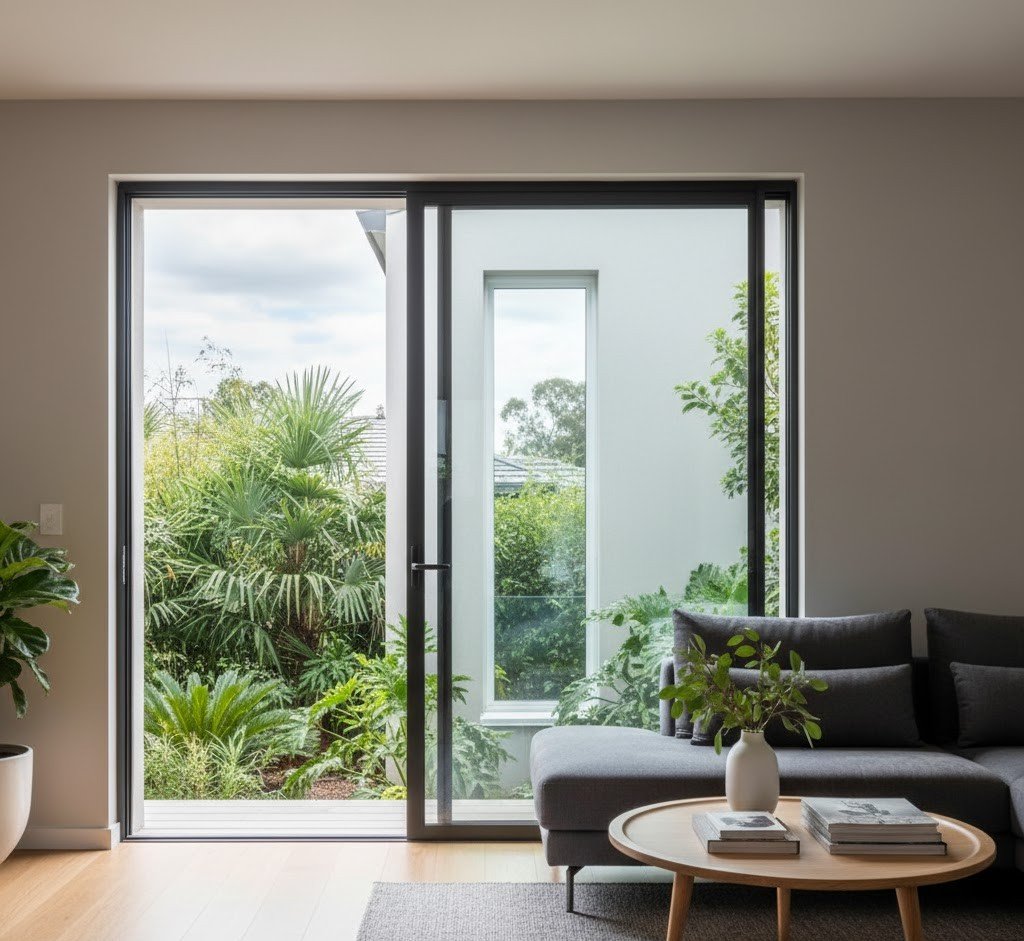Key Takeways:
-
Vertical (hung) windows slide up/down, offering classic style, ventilation control, and easy cleaning but lower energy efficiency.
-
Horizontal (slider) windows glide side-to-side, ideal for wide spaces, modern aesthetics, and accessibility with easier installation.
-
Double hung windows allow two movable sashes for flexible airflow, while sliders provide larger openings for maximum ventilation.
-
Hung windows cost about $140–$400, while slider windows generally range from $415–$890 depending on size and material.
Are you looking to upgrade your home with new windows? You may be considering the options between vertical/double hung windows and horizontal sliding windows. Both of them are some of the best replacement windows. But which one is better for your needs?
When it comes to replacing or installing new windows, there are many factors that come into play. Cost, style, efficiency – all of these can influence what type of window is right for you. And when it comes to choosing between vertical and horizontal sliding windows, understanding the differences can help make sure you get the best fit for your home.
In this article, we’ll compare both types of sliding windows so that you can make an informed decision on which one is right for you. We’ll look at how they function differently as well as their advantages and disadvantages in terms of design and energy-efficiency ratings. So if you want to find out more about Which One Is Better – Vertical or Horizontal Sliding Windows – read on!

What are vertical sliding windows or hung windows?
Vertical sliding windows, also known as Hung windows, are a popular choice for home installations due to their stylish design and energy-efficiency. Hung windows feature sashes that slide up and down in tracks, allowing them to be opened from the top or bottom. This style of window offers several advantages over other types of windows, such as easy cleaning access and improved ventilation control.
Types of hung windows
The following are the three types of sliding windows:
- Single hung windows
- Double hung windows
- Three lite windows
A single hung window or vertical sliding window is made up of two sashes. It has a fixed upper sash, while the lower sash slides up and down within the window frame to minimize or maximize the window opening. Double Hung Windows feature two sliding sashes in the same frame, which can tilt for easy cleaning. Three-Lite Windows are usually seen in bow & bay window configurations and have multiple sliders on each side. Out of these three vertical hung windows, Double Hung Windows are the most popular choice for homes. Some of the most common applications for these windows include living rooms, bedrooms, bathrooms, kitchens, dining rooms and more. These windows are made with aluminium and uPVC frames. Unlike wooden window frames, these frames are durable, long lasting and low maintenance.
uPVC Single/Double Hung Window
When it comes to our UPVC single/double hung windows, we offer two profile systems. American series are known for their slim yet attractive design while European series provide superior durability compared to their American counterparts. If you would like further details about these windows please visit our product page or our product pages.

Aluminium Single / Double Hung Window
We offer a range of high-quality aluminum single and double hung windows. Our collection includes the non-thermal aluminum profile 70 single hung series and the 83 double hung series. These windows are designed to provide exceptional durability and aesthetic appeal.
Our aluminum single hung windows feature a sleek and stylish design, perfect for both residential and commercial applications. The non-thermal profile ensures excellent insulation, keeping your space comfortable and energy-efficient. Available in stock, we offer these windows in classic colors such as white, black, grey, and bronze, allowing you to find the perfect match for your architectural style.
For those looking for versatile and functional windows, our aluminum double hung series is an excellent choice. With two operable sashes, these windows provide enhanced ventilation control and ease of cleaning. Crafted with precision, the double hung windows offer a seamless combination of functionality and elegance.
What are horizontal sliding windows or slider windows?
Horizontal sliding windows, also known as Slider windows, feature sashes that slide side to side instead of up and down. This type of window is ideal for wide expanses or openings, as the sashes can be adjusted to fit the space perfectly. Additionally, Slider windows are easier to open and close than Hung windows – making them a great choice for homes with limited mobility. These windows can range in size from small to large and operate much like a patio door – they open with an easy gliding motion. The horizontal sliders can also be further divided in to two types i.e. single sliding sash windows and double slider windows.
Common applications of horizontal sliding windows include living rooms, bedrooms, bathrooms, kitchens, and dining rooms. They are often used in these spaces due to their modern design and ability to bring in more natural light. In addition to that, they are also popularly used in commercial applications like office and retail buildings.

How double hung windows and vertical sliding windows function differently?
The working mechanism of both of these sliding windows is same i.e. sliding. The biggest difference between them is the way they open. Double hung windows open from the top or bottom, while Slider windows slide horizontally.
Another difference between the two is the way they are installed. Hung windows require extra hardware like pulleys, weights, and springs to operate correctly, while Slider windows do not. This makes them easier to install and often less expensive than other types of windows.
The design choice makes a big difference in terms of ventilation – depending on your needs, you may want to opt for one type of window over another.
Pros and cons of both double hung windows and horizontal windows
When considering which type of window is best for your home, it’s important to consider the advantages and disadvantages of each.
Pros of double/single hung windows:
There are many benefits to choosing a vertically hung window. The following are some of the important one:
- Easy cleaning access – Cleaning is made easier with hung windows as they can be opened from the top or bottom. You can easily reach the exterior glass with a duster or sponge.
- Improved ventilation control – The control of ventilation is much better with hung windows compared to slider windows. The two sashes of a double-hung window can be opened at different levels, allowing for more control over the amount of airflow.
- Traditional style that fits most homes – Single and double-hung windows are a classic design choice for homes, making them a popular option. You can find these windows in a variety of shapes, sizes, and colours to fit your home’s style.
- Affordability – In most cases, hung windows are less expensive than other types of windows. For example, the cost of a single hung window is around $140-$400, while on the other hand, a sliding window costs you around $415-$890.
- A better option than casement windows – The problem with casement windows is that they are difficult to open in small spaces. Single- and double-hung windows, on the other hand, take up minimal space when opened, making them a much better option in tight areas.
So these are the benefits of double/single hung windows. Now let’s move on to see the other side of the hung windows.
Cons of vertical/hung windows:
- Require more hardware for installation – Installation is more complicated with hung windows as they require extra hardware to operate properly. They require weights, pulleys and professional experience to be installed correctly. In case you are a DIYer, it is not recommended to install them yourself.
- Chances of falls shut – Hung windows are more prone to falls shut due to their heavy weight, which can be dangerous. This usually doesn’t happen with new windows. However, with the passage of time and due to wear and tear, the balance shoes get disconnected or misplaced which then leads to the window falling.
- Less energy efficient than other types of windows – The traditional design of hung windows does not always offer the highest levels of insulation. The air gaps between the sashes can cause air to escape and reduce energy efficiency.
- Difficult to open/close if mobility is an issue – Due to their design, hung windows may be difficult to open and close for those with limited mobility.
What are the pros of Horizontal Sliding Windows?
There are several benefits to choose a horizontal sliding window over other types of windows. The following are some of the important ones:
- Ease of installation – Installation is much easier with sliding windows as they don’t require any extra hardware for operation. Even a beginner can install it without much effort.
- Easy to open and close – The biggest advantage of horizontal sliding windows is that they are easy to open and close, making them a great choice for homes with limited mobility.
- Aesthetics – Slider windows are available in a variety of styles and designs. This allows you to choose the best window for your home’s aesthetic.
- Great ventilation – With a larger opening than other types of windows, slider windows allow for more airflow into a room.
- Modern design – The sleek lines of horizontal sliding windows add to the modern look of a home.
- Wide range of sizes available – Slider windows come in a wide variety of sizes, making them ideal for both small and large openings.
- Cheaper than hung windows – Sliding windows offer a more cost-effective solution compared to hung windows due to their simple hardware design.
Cons of Horizontal Sliding Windows:
- Require more space for installation – Slider windows need room on both sides of the window for installation, so it may not be a practical choice for narrow spaces.
- Poor airtightness and heat insulation – Due to its simpler hardware system, the sliding window may not provide the same level of tight closure as a hung window. Consequently, this can result in reduced heat insulation compared to a hung window.
Factors to consider when choosing between the two
There are a few factors to consider when choosing between double hung windows and horizontal sliding windows for your home. These factors will also help you decide which is more suitable for your needs:
Space
Space is a major consideration when deciding between a double hung window, as well as horizontal sliding window. First of all, ask yourself, what kind of space do you have in your home? If you have a narrow space, hung windows may be a better option as they require less room for installation. on the other hand, if you have a wider space, slider windows may be the better choice.
Ventilation
The primary purpose of a window is to provide ventilation. Double hung windows offer more control over the amount of airflow than slider windows, but slider windows allow for a larger opening, providing better ventilation. When deciding between the two, take into consideration how much ventilation you want in your home and which type of window will provide it.
Budget
Another factor to consider when choosing between the two is budget. Slider windows are typically more affordable than single or double hung windows, making them a great choice for those who are on a tight budget. However, if you have the extra money to spend, single or double hung windows may be a better option due to their modern style and larger opening.
Location
The location of your window will also come into play when making a decision between double hung and slider windows. If you have an upstairs window, double hung windows may be the best choice, as they are easier to open and close when located in a high area. On the other hand, if you have a window located on the ground floor, slider windows may be more suitable.
Window Style
Finally, consider the style of your home and which type of window would best suit it – hung windows are the classic choice for traditional homes, while slider windows offer a more modern look.
Which One you should choose – Vertical or Sliding Window?
The choice of vertical or sliding window will depend on the needs and preferences of each individual. Guidelines like size, budget, ventilation, window styles and installation should all be taken into account when determining which type of window is best for your home. For example, if you need a window that allows for easy access and ventilation, a double-hung window may work best. However, if you need more control over airflow and have limited mobility, a sliding window may be a better choice. Ultimately, the decision of which type of window is best for your home is up to you.
| Vertical / Hung | Horizontal / Sliding | |
|---|---|---|
| Opens | Up & down | Side to side |
| Best For | Small/narrow spaces | Wide openings |
| Style | Classic/traditional | Modern/sleek |
| Ease of Use | Harder for mobility | Very easy to use |
| Cost | Lower ($140–$400) | Higher ($415–$890) |
Conclusion:
Choosing between vertical (hung) windows and horizontal (sliding) windows comes down to your space, budget, and style preferences. Hung windows are a timeless choice, offering better airflow control and a traditional design, while sliding windows provide a sleek, modern look with easy operation and wide openings.
At Oridow, we specialize in delivering high-quality, energy-efficient windows designed to fit every type of home. Whether you prefer the classic appeal of double-hung windows or the contemporary style of horizontal sliders, our experts can help you select the perfect option for comfort, savings, and long-lasting durability.
1. What are vertical sliding (hung) windows?
-
Also called single-hung or double-hung windows
-
Operate by sliding up and down
-
Common in bedrooms, living rooms, kitchens, and bathrooms
-
Available in uPVC and aluminum frames
2. What are horizontal sliding (slider) windows?
-
Open by sliding side-to-side on a track
-
Ideal for wide spaces and ground-floor installations
-
Operate like a patio door with a smooth gliding motion
-
Popular in both homes and commercial buildings
3. What are the main types of vertical hung windows?
-
Single Hung → one fixed sash, one movable sash
-
Double Hung → two movable sashes, better ventilation
-
Three-Lite Windows → used in bow & bay window setups
4. Which window type is easier to clean?
-
Double-hung windows tilt inward for easy cleaning
-
Single-hung windows allow some access but less flexible
-
Sliding windows need only track cleaning, very simple
5. Which windows are better for ventilation?
-
Double-hung windows → precise control with two operable sashes
-
Sliding windows → larger openings, more airflow at once
6. Which type of window is more affordable?
-
Single-hung windows: $140–$400 (budget-friendly)
-
Double-hung windows: slightly higher cost
-
Sliding windows: $415–$890 (varies by size & material)
7. Are sliding windows good for energy efficiency?
-
Provide good insulation but may have weaker airtight seals
-
Hung windows can lose efficiency due to air gaps between sashes
-
Frame material (uPVC vs aluminum) also affects insulation
8. Which windows are better for small spaces?
-
Vertical/hung windows are better for narrow walls
-
Sliding windows need more horizontal space for installation
9. Are these windows easy to install?
-
Hung windows → need extra hardware (pulleys, weights, springs), harder to DIY
-
Sliding windows → simple design, easier and quicker to install
10. Which should I choose: vertical or horizontal sliding windows?
-
Pick Vertical/Hung if:
-
You want a traditional style
-
Need better airflow control
-
Prefer easy tilt-in cleaning
-
-
Pick Horizontal/Sliding if:
-
You want a modern look
-
Need windows for wide openings
-
Want easy operation for mobility
-





